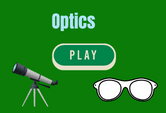Optics Questions and Answers Game Trivia
This page features an Optics Questions and Answers Game Trivia Online. Check out this game and learn this physics concept in a fun and interactive way. This game is great for classrooms and at home. Click and start learning. 5th, 6th, 7th, 8th and 9th grades.
Multiple Choice Questions On Optics

What do you call light that is produced by heat?
- Fluorescence
- Effervescence
- Incandescence
- Bioluminescence
What kind of lens is thicker in the middle?
- Concave
- Converse
- Condensed
- Convex
Objects that transmit light but scatter it in the process are considered…
- Opaque
- Transparent
- Translucent
- Black
Concave lenses cause light to _______, while convex lenses cause light to _______.
- Diverge, converge
- Converge, diverge
- Diverge, diverge
- Converge, converge
This is the distance from the focal point to the center of the lens.
- Focal gap
- Focal length
- Focal latitude
- Focal range
Which lens is used by magnifying glasses?
- Convex
- Concave
- Telephoto
- Wide
You’re an ophthalmologist helping a nearsighted person choose their glasses. Which lens should their glasses have to correct their nearsightedness?
- Convex
- Concave
- Both
- They shouldn’t wear glasses
Which kind of electromagnetic radiation can human eyes see?
- Ultraviolet
- Infrared
- X-ray
- None of the above
Bananas are yellow because they _______ yellow light and _______ all other light.
- Absorb, reflect
- Absorb, absorb
- Reflect, reflect
- Reflect, absorb
Objects appear black because they…
- Absorb all light
- Reflect all light
- Absorb black light
- Reflect black light
What do you call a material that does not transmit light?
- Transparent
- Opaque
- Semi-transparent
- Translucent
The separation of light into its seven different constituent colors is known as…
- Reflection
- Refraction
- Dispersion
- Diffusion
What do you call the property of light travelling in a straight line?
- Rectilinear propagation
- Rectilinear propulsion
- Rectilinear projection
- Rectilinear production
Objects with a higher refractive index make light travel…
- Faster
- Slower
- At the same speed
- They stop light from travelling
What kind of image is formed by the actual intersection of light rays?
- Virtual image
- Semi-virtual image
- Fake image
- Real image
What is optics in science?
Optics is a branch of physical science that studies light's behavior and properties, as well as its interaction with matter. It also includes the instruments used to detect it. How do visible, ultraviolet and infrared light behave? Play this physical science game to find out more about light and optics.
Optics and light
This article will teach you about light. This includes laws of reflection and lenses, refraction and non-visible electromagnetic spectrum. The unit includes all components and lesson plans for each topic.
Newton's views about light
Newton's scientific theory about light was based upon a speculative view of light: it was material corpuscles moving in motion. This idea was speculative and did not address the issue of gravitational force acting on an empty space or frictionless medium. However, he did demonstrate that light can be divided into distinct spectral colors. This makes light a spectrum of colors that can be seen by humans.
Snell's laws for refraction
Snell's law on refraction in optics and light refers to the angle of refraction relative to the refractive indice of the second medium. This fundamental principle can be used in many fields. Snell's law, for example, states that light will bend towards itself when it travels through a medium having a lower refractive Index than the medium in which it is first traveling. This law can also apply to rainbows.
Optics are used in modern medical applications
Scientists have been able to use modern medical applications of light and optics in order to diagnose and treat various diseases. Modern imaging tools and diagnostics have made it possible for physicians to perform more accurate procedures. The essential tool for diagnosing diabetes and other diseases is optical spectroscopy, also known as spectroscopy. The diagnosis of cancer and other diseases can be made easier by using optical spectroscopy. Photonics also plays a significant role in drug development, quality control, and other areas.
Fiber optics
Fiber optics is closely related to light. The most important aspect of light reflection is one of the most important. A fiber is composed of a core of clear glass and its cladding has a layer of glass. The primary function of the cladding is to maintain total internal reflection (TIR). When the core glass is reduced by the cladding, fibers can experience loss. The thickness of the cladding can affect how much cladding is lost. Cladding loss can be as low as five percent up to as high as 25%. Common multimode step index fibers have a loss rate around 17%.
